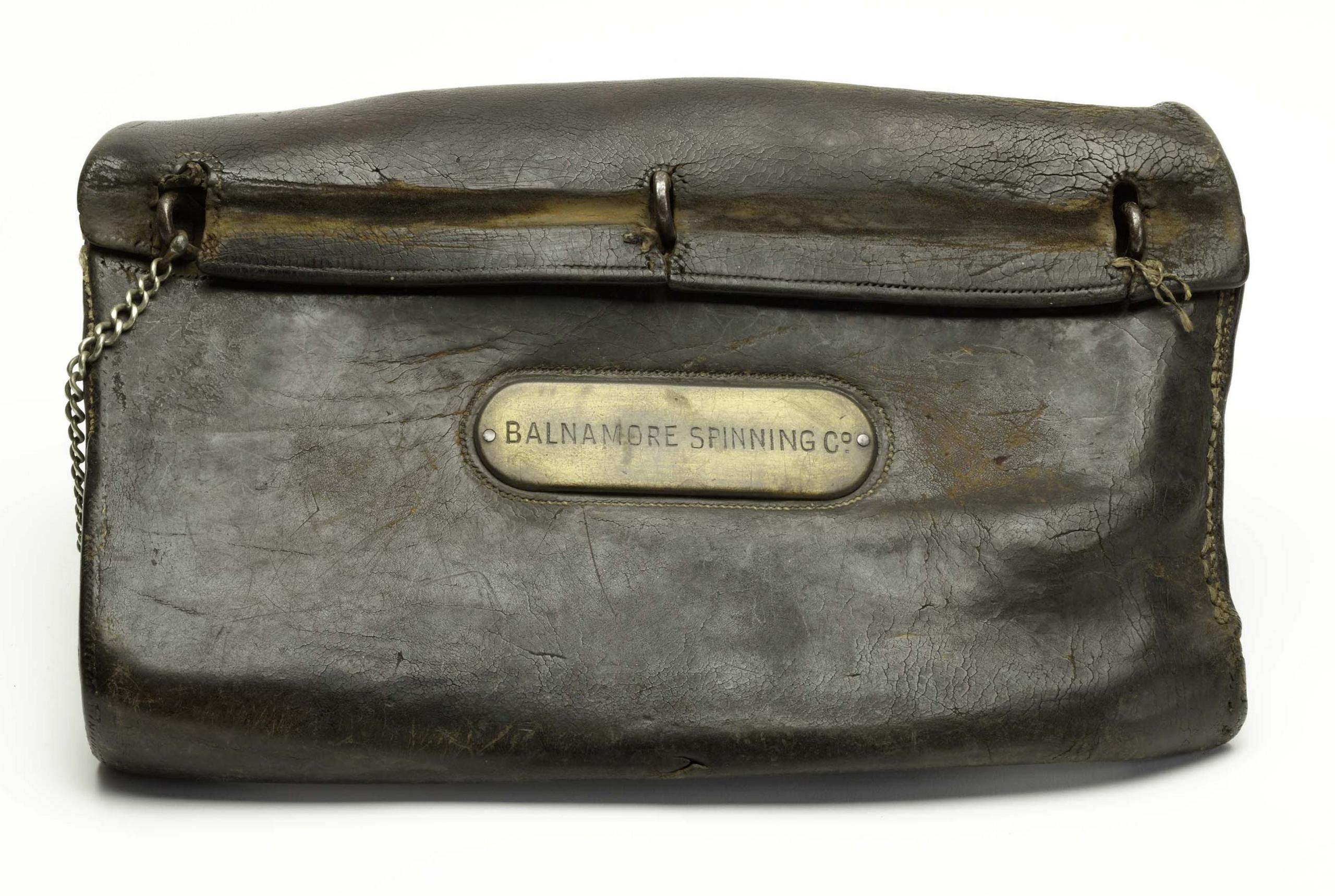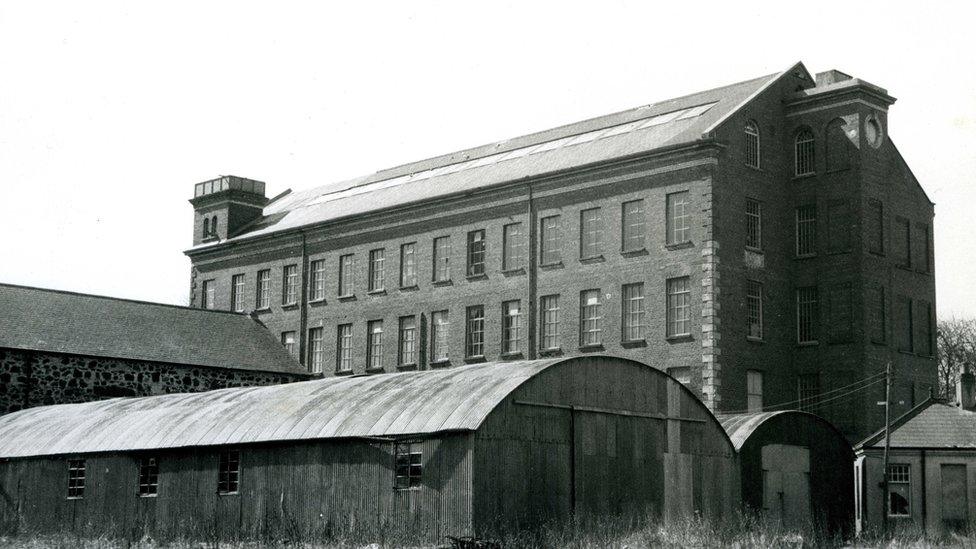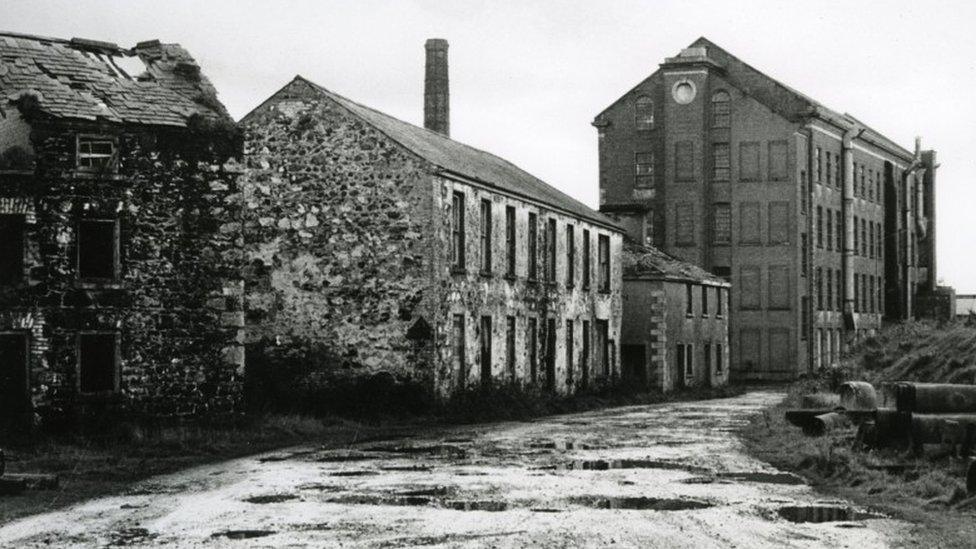William Orr: The blind postman who delivered a first-class service
- Published

The leather satchel William Orr used to deliver mail to Balnamore Mill is on display in Ballymoney Museum
In the 1920s, postman William Orr walked for miles every day along rural roads to deliver mail, despite the fact that he was registered as blind.
He was employed as a postal worker at Balnamore Mill in County Antrim.
Despite his visual impairment, he regularly carried mail between the mill and the nearest town, Ballymoney, a journey of about two-and-a-half miles.
His life and livelihood is now being studied as part of a UK-wide history project, involving the Postal Museum in London and four English universities.
The Addressing Health, external project is examining the health and mortality rates of postal workers during the Victorian and Edwardian eras - a period stretching from 1837 to 1910.
The research into William Orr is being led by Laura Newman from King's College London.
"William Orr is unusual because he did postal work but was not employed by the Post Office," she told BBC News NI.
"Instead he was privately employed as a postman by Balnamore Mill.
"Despite this, we think his story is still worth telling because of what it can tell us about disabled people's experiences of doing postal work."

Balnamore Mill was one of the largest spinning mills outside of Belfast
As part of the project, the research team is inviting descendants of postal workers from this period to share recollections of their relatives.
They have not yet tracked down any of William Orr's living relatives, but thanks to help from Peter Gibson, a family researcher from Northern Ireland, they already "know quite a bit" about him.
"William was born in 1872 in Belfast, the son of a plasterer. William, however, was orphaned before the age of five," Newman explained.
She believes he moved to Balnamore to live with his aunts and uncle, two of whom were employed as part of the mill's "thriving linen industry".
"We know from the 1901 Irish census that he was working as a postman at this point. He was also still a postman in the 1911 census," Newman added.
"We do not know the extent of William's sight loss, but he was registered as blind on the 1911 census."
Carrying heavy sacks of mail along country roads would have brought its own health and safety challenges in Edwardian times, but not being able to see properly made it extra risky.
'He didn't need a stick'
However, William had "no trouble finding his way from Ballymoney to the mill and back again in the course of his duties", according to a spokesman for Causeway Coast and Glens Council's Museum Services.

Balnamore Mill was an important source of employment for hundreds of families
The leather satchel William used to carry mail is on permanent display at the council-run Ballymoney Museum.
Among the residents who remembered seeing him on his rounds was the late Mollie Holmes, a former mayor of Ballymoney Borough Council.
She died in 2016 at the age of 101, but her recollections have been documented by the museum, external.
'I used to watch him pass by while I was visiting my grandmother," Mrs Holmes said.
"He always walked with confidence, he didn't need a stick, because he knew his route so well.
"When I saw his mailbag on display many years later at the museum, it brought back happy childhood memories."
The council's spokesman described the Balnamore mailbag as a "key object telling the story of trade in Ballymoney", as the mill was an important employer in the area.
Built on a former corn mill site, the Balnamore business developed into one of the largest flax spinning mills outside of Belfast.

Workers in the reeling room in Balnamore Mill
At the height of its trade in the 19th Century, it employed more than 400 people and created its own community.
According to the the council's website, external: "A village began to develop around the mill, with houses for employees, a shop and a school. In later years, there was even a football team."
The mill's fortunes faded with the decline of the linen industry and it closed it 1959.
But one of its few surviving artefacts recently caught the attention of the English research team.
"We were looking for museums to partner up with so we could reach the public and tell exciting new stories about histories of postal work," Newman said.
"We came across Ballymoney Museum's mailbag online and felt it was a really exciting object we could do a lot of work with."
Other blind postmen found
Their research is ongoing, and there is still much to be investigated.
"The bag dates from the 1920s so it seems like William was working in this role for a while," added Newman.
"We have also uncovered other instances of blind postmen who worked in Ireland, who we are currently still researching.
"One was delivering post in Derry during the Wolfe Tone Rebellion [1798]. The other postman was based in Wexford and was a skilled fiddler."
It is not known how long William Orr worked as a postman, but he died after a heart attack in 1939, aged 66.
According to Newman, mortality information forms an important part of the three-year research project.

Laura Newman is a postdoctoral research associate at King's College London
"It explores the timing and geography of ill health among postal workers, and the responses of the Post Office and medical authorities," she explained.
"By tracing these workers through from retirement until they died, the project also explores the links between ill health, mortality, and the workplace.
"So we want to answer questions like: what were the effects of postal work on an individual's health?
"Were Scottish postal workers healthier than Irish postal workers? And so on."
If you are related to an Edwardian or Victorian postal worker, or to William Orr himself, you can share your family's stories with the researchers by completing their online survey - Our Postal Ancestors, external.